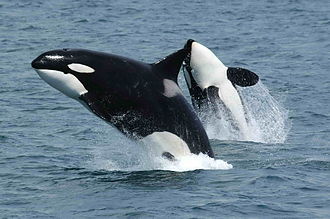- Orcas, also known as killer whales, are the largest members of the dolphin family.
- They are highly intelligent marine mammals, exhibiting complex social structures and behaviors.
- Orcas can be found in oceans around the world, from the Arctic to the Antarctic regions.
- They have a distinct black and white coloration, with a white underside and a black upper body.
- Orcas have a diverse diet and are known to eat fish, seals, sea lions, and even other whales.
- They are apex predators and are considered the top predators in the marine ecosystem.
- Orcas are highly vocal and communicate with each other using a variety of clicks, whistles, and calls.
- They live in family groups known as pods, which can consist of several individuals.
- Each pod has its own unique dialect and vocal repertoire, allowing them to distinguish between different groups.
- Orcas are known for their remarkable hunting strategies, such as cooperative hunting and beaching to catch prey.
- They have a long lifespan, with some individuals living up to 80 years or more.
- Orcas are known for their exceptional swimming abilities, capable of reaching speeds of up to 34.5 miles per hour (56 kilometers per hour).
- They have a powerful and streamlined body, allowing them to navigate through the water with ease.
- Orcas are highly social animals, forming strong bonds within their pod and displaying cooperative behaviors.
- They have a complex social structure, with individuals often staying with their pod for life.
- Orcas display remarkable maternal care, with mothers nursing their calves for up to two years.
- They have a sophisticated hunting technique, using coordinated movements and strategic positioning to capture their prey.
- Orcas have been observed using tools, such as sponges, to protect their noses while foraging on the ocean floor.
- They are known for their acrobatic behavior, including breaching, spy-hopping, and tail-slapping.
- Orcas have a well-developed sense of echolocation, using sound waves to navigate and locate prey.
- They are found in both cold and warm waters, adapting to a wide range of marine environments.
- Orcas have been known to interact with humans in the wild, sometimes approaching boats and displaying curiosity.
- They have been revered and depicted in the mythology and folklore of many indigenous cultures.
- Orcas have a diverse range of ecotypes, with some populations specializing in hunting fish while others focus on marine mammals.
- They have been studied extensively in captivity, providing valuable insights into their biology and behavior.
- Orcas are known to display cultural behaviors, passing on knowledge and traditions from one generation to another.
- They are known to migrate over long distances, following food sources and seasonal patterns.
- Orcas have been the subject of conservation efforts, as some populations are endangered or face threats from pollution, habitat loss, and overfishing.
- They have a complex and sophisticated brain, exhibiting social and cognitive abilities similar to those of humans.
- Orcas have been observed engaging in play behavior, including interacting with objects and each other.
- They have a layer of blubber that provides insulation and energy reserves in colder waters.
- Orcas have a powerful tail, or fluke, that propels them through the water.
- They have a versatile diet, adapting to the availability of prey in their environment.
- Orcas are known for their curiosity, often approaching and investigating unfamiliar objects or animals.
- They have a hierarchical social structure within their pods, with dominant individuals leading and coordinating group activities.
- Orcas have few natural predators, with adult individuals having few threats in the wild.
- They are highly adaptable and have been observed successfully hunting in a variety of environments and prey types.
- Orcas have a reputation for being highly intelligent and have been studied for their problem-solving abilities.
- They are capable of complex vocalizations, including imitating human speech and other sounds.
- Orcas have been trained and used in marine parks and aquariums for entertainment purposes, although this practice has become controversial in recent years.
- They have a well-developed sense of hearing and can communicate over long distances underwater.
- Orcas have been known to engage in play behavior with other marine species, such as dolphins and sea lions.
- They have a strong sense of family and demonstrate protective behaviors towards their pod members.
- Orcas are known to display cultural variations, with different pods exhibiting distinct behaviors and hunting techniques.
- They have been observed teaching their young how to hunt and forage for food.
- Orcas have a complex reproductive system, with females giving birth to a single calf after a gestation period of around 15 to 18 months.
- They are highly adaptable to captivity and have been successfully trained for various behaviors and performances in marine parks.
- Orcas have a complex dental structure, with sharp teeth used for catching and tearing prey.
- They are highly regarded by scientists for their role as indicator species, reflecting the health and condition of marine ecosystems.
- Orcas are fascinating creatures that continue to capture the interest and curiosity of researchers and the public alike, with ongoing efforts focused on understanding and protecting these magnificent marine mammals.
Facebook Comments


































